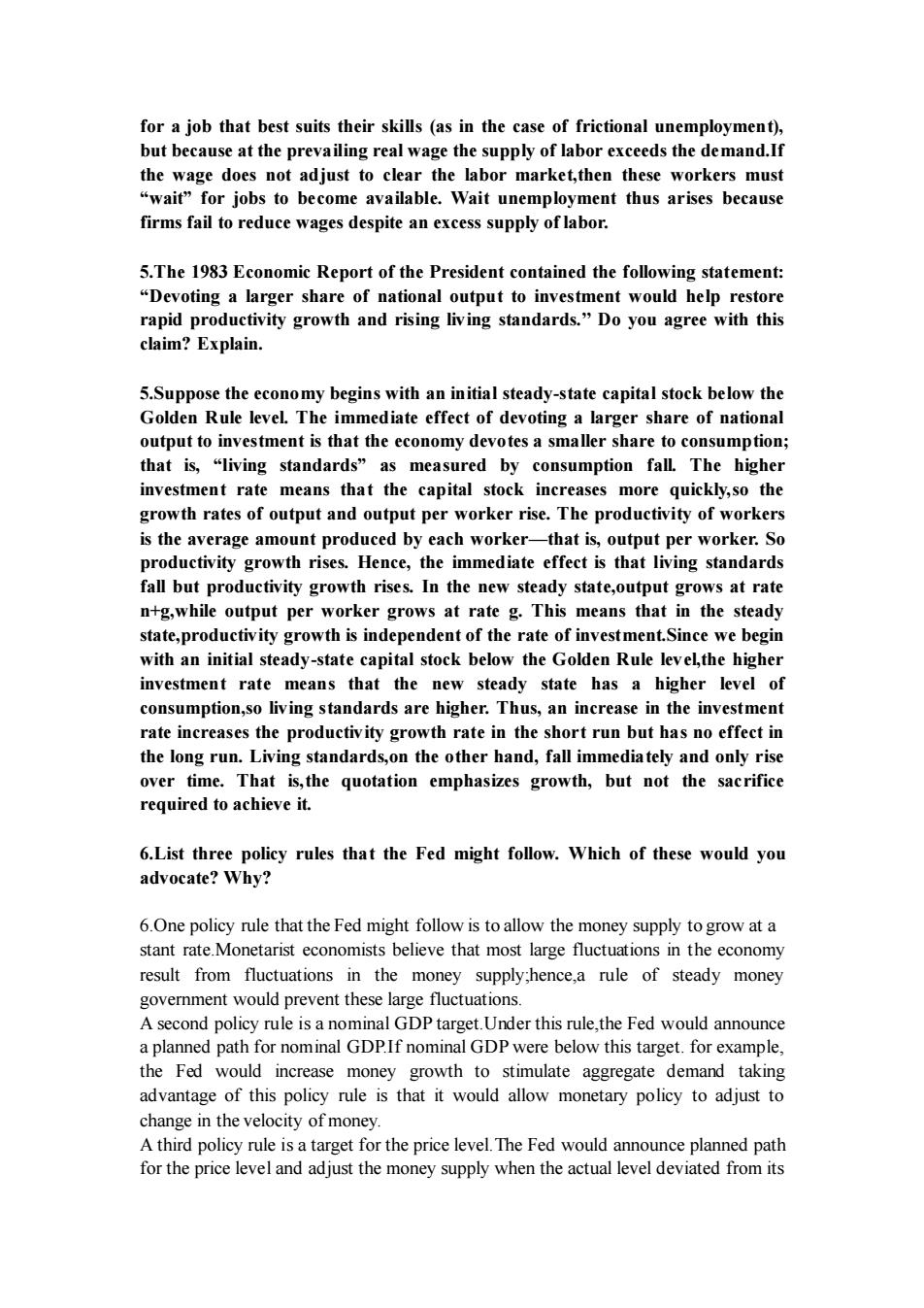正在加载图片...

for a iob that best suits their skills (as in the case of frictional unemployment) but because at the prev ailing real wag supply of lab r ex the wage does s not adjust to clear the labor market,then workers mus "wait"for jobs to become available.Wait unemployment thus arises because firms fail to reduce wages despite an excess supply of labor. 5.The 1983 Economic Report of the President contained the followir statement: "D evoting a larger share of national output to inve nt would help resto rapid productivity growth and rising living standards."Do you agree with this claim?Explain. 5.Suppose the economy begins with an initial steady-state capital stock below the Golden Rule level.The ediate share of tio output to investment is that the economy devotes a smaller sharet sumption that is,"living standards"as measured by consumption fall.The higher investment rate means that the capital stock increases more quickly,so the growth rates of output and output per worker rise.The productivity of workers is the age am produ that is productivity growth rises.Hence,the er worker mmediate effect is that living standard fall but productivity growth rises.In the new steady state,output grows at rate n+g,while output per worker grows at rate g.This means that in the steady state,productivity growth is independent of the rate of investment.Since we begin with an initial st ady-state capital stock below the Golden Rule level,the higher nvestmer rate means that the new steady state has a higher level of consumption,so living standards are higher.Thus,an increase in the investment rate increases the productivity growth rate in the short run but has no effect in the long run.Living standards,on the other hand,fall immediately and only rise over time.That is,the quotation emphasizes growth,but not the sacrifice required to achieve it. 6.List three policy rules that the Fed might follow.Which of these would vou advocate?Why? 6.One policy rule that the Fed might follow is toallow the money supply to grow at a rate Monetarist economists believe that most large fluctua s in the economy result from fluctuations in the money supply hence a rule of steady money government would prevent these large fluctuations. A second policy rule is a nominal GDP target.Under this rule,the Fed would announce a planned path for nominal GDPIf nominal GDP were below this target.for example. the Fed we oney growth to stir aggrega“ demand taki advantage of this policy rule is that it would allow monetary policy to adjust to change in the velocity of money. A third policy rule is a target for the price level.The Fed would announce planned path for the price level and adjust the money supply when the actual level deviated from its for a job that best suits their skills (as in the case of frictional unemployment), but because at the prevailing real wage the supply of labor exceeds the demand.If the wage does not adjust to clear the labor market,then these workers must “wait” for jobs to become available. Wait unemployment thus arises because firms fail to reduce wages despite an excess supply of labor. 5.The 1983 Economic Report of the President contained the following statement: “Devoting a larger share of national output to investment would help restore rapid productivity growth and rising living standards.’’ Do you agree with this claim? Explain. 5.Suppose the economy begins with an initial steady-state capital stock below the Golden Rule level. The immediate effect of devoting a larger share of national output to investment is that the economy devotes a smaller share to consumption; that is, “living standards” as measured by consumption fall. The higher investment rate means that the capital stock increases more quickly,so the growth rates of output and output per worker rise. The productivity of workers is the average amount produced by each worker—that is, output per worker. So productivity growth rises. Hence, the immediate effect is that living standards fall but productivity growth rises. In the new steady state,output grows at rate n+g,while output per worker grows at rate g. This means that in the steady state,productivity growth is independent of the rate of investment.Since we begin with an initial steady-state capital stock below the Golden Rule level,the higher investment rate means that the new steady state has a higher level of consumption,so living standards are higher. Thus, an increase in the investment rate increases the productivity growth rate in the short run but has no effect in the long run. Living standards,on the other hand, fall immediately and only rise over time. That is,the quotation emphasizes growth, but not the sacrifice required to achieve it. 6.List three policy rules that the Fed might follow. Which of these would you advocate? Why? 6.One policy rule that the Fed might follow is to allow the money supply to grow at a stant rate.Monetarist economists believe that most large fluctuations in the economy result from fluctuations in the money supply;hence,a rule of steady money government would prevent these large fluctuations. A second policy rule is a nominal GDP target.Under this rule,the Fed would announce a planned path for nominal GDP.If nominal GDP were below this target. for example, the Fed would increase money growth to stimulate aggregate demand taking advantage of this policy rule is that it would allow monetary policy to adjust to change in the velocity of money. A third policy rule is a target for the price level.The Fed would announce planned path for the price level and adjust the money supply when the actual level deviated from its